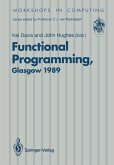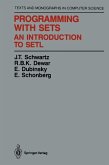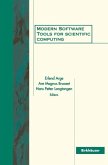Jan L. A. van de Snepscheut
What Computing Is All About (eBook, PDF)
62,95 €
62,95 €
inkl. MwSt.
Sofort per Download lieferbar

31 °P sammeln
62,95 €
Als Download kaufen

62,95 €
inkl. MwSt.
Sofort per Download lieferbar

31 °P sammeln
Jetzt verschenken
Alle Infos zum eBook verschenken
62,95 €
inkl. MwSt.
Sofort per Download lieferbar
Alle Infos zum eBook verschenken

31 °P sammeln
Jan L. A. van de Snepscheut
What Computing Is All About (eBook, PDF)
- Format: PDF
- Merkliste
- Auf die Merkliste
- Bewerten Bewerten
- Teilen
- Produkt teilen
- Produkterinnerung
- Produkterinnerung

Bitte loggen Sie sich zunächst in Ihr Kundenkonto ein oder registrieren Sie sich bei
bücher.de, um das eBook-Abo tolino select nutzen zu können.
Hier können Sie sich einloggen
Hier können Sie sich einloggen
Sie sind bereits eingeloggt. Klicken Sie auf 2. tolino select Abo, um fortzufahren.

Bitte loggen Sie sich zunächst in Ihr Kundenkonto ein oder registrieren Sie sich bei bücher.de, um das eBook-Abo tolino select nutzen zu können.
This book will be for a first or second year undergraduate course in computer science. Assuming that a student already has had one course in programming, the text introduces various topics of computer science, in a way that shows their application and promotes real interest.
- Geräte: PC
- ohne Kopierschutz
- eBook Hilfe
- Größe: 38.6MB
Andere Kunden interessierten sich auch für
![Functional Programming (eBook, PDF) Functional Programming (eBook, PDF)]() Functional Programming (eBook, PDF)40,95 €
Functional Programming (eBook, PDF)40,95 €![Coloured Petri Nets (eBook, PDF) Coloured Petri Nets (eBook, PDF)]() Kurt JensenColoured Petri Nets (eBook, PDF)48,95 €
Kurt JensenColoured Petri Nets (eBook, PDF)48,95 €![PROLOG for Computer Science (eBook, PDF) PROLOG for Computer Science (eBook, PDF)]() Christopher DawePROLOG for Computer Science (eBook, PDF)40,95 €
Christopher DawePROLOG for Computer Science (eBook, PDF)40,95 €![Programming with Sets (eBook, PDF) Programming with Sets (eBook, PDF)]() J. T. SchwartzProgramming with Sets (eBook, PDF)72,95 €
J. T. SchwartzProgramming with Sets (eBook, PDF)72,95 €![The Ada® Generic Library (eBook, PDF) The Ada® Generic Library (eBook, PDF)]() David R. MusserThe Ada® Generic Library (eBook, PDF)72,95 €
David R. MusserThe Ada® Generic Library (eBook, PDF)72,95 €![FSTTCS 2004: Foundations of Software Technology and Theoretical Computer Science (eBook, PDF) FSTTCS 2004: Foundations of Software Technology and Theoretical Computer Science (eBook, PDF)]() FSTTCS 2004: Foundations of Software Technology and Theoretical Computer Science (eBook, PDF)40,95 €
FSTTCS 2004: Foundations of Software Technology and Theoretical Computer Science (eBook, PDF)40,95 €![Modern Software Tools for Scientific Computing (eBook, PDF) Modern Software Tools for Scientific Computing (eBook, PDF)]() Modern Software Tools for Scientific Computing (eBook, PDF)72,95 €
Modern Software Tools for Scientific Computing (eBook, PDF)72,95 €-
-
-
This book will be for a first or second year undergraduate course in computer science. Assuming that a student already has had one course in programming, the text introduces various topics of computer science, in a way that shows their application and promotes real interest.
Dieser Download kann aus rechtlichen Gründen nur mit Rechnungsadresse in A, B, BG, CY, CZ, D, DK, EW, E, FIN, F, GR, HR, H, IRL, I, LT, L, LR, M, NL, PL, P, R, S, SLO, SK ausgeliefert werden.
Produktdetails
- Produktdetails
- Verlag: Springer US
- Seitenzahl: 478
- Erscheinungstermin: 6. Dezember 2012
- Englisch
- ISBN-13: 9781461227106
- Artikelnr.: 44184139
- Verlag: Springer US
- Seitenzahl: 478
- Erscheinungstermin: 6. Dezember 2012
- Englisch
- ISBN-13: 9781461227106
- Artikelnr.: 44184139
- Herstellerkennzeichnung Die Herstellerinformationen sind derzeit nicht verfügbar.
1 What Is Computing All About? 1.- 2 Grammars 11.- 2.1 Strings and Languages.- 2.2 Grammars.- 2.3 The Language Defined by a Grammar.- 2.4 Bibliographic Notes.- 2.5 Exercises.- 3 A Program Notation.- 3.1 Introduction.- 3.2 The Simple Statements.- 3.3 The Conditional Statement.- 3.4 The Iterative Statement.- 3.5 Procedures.- 3.6 Recursion.- 3.7 Bibliographic Notes.- 3.8 Exercises.- 4 Regular Expressions.- 4.1 Right-Linear Grammars.- 4.2 Transition Graphs.- 4.3 Regular Expressions.- 4.4 The Relation Between the Three Formalisms.- 4.5 Equivalence Relations and Finite-State Automata.- 4.6 Bridling Nondeterminism.- 4.7 Bibliographic Notes.- 4.8 Exercises.- 5 Integrated Circuits.- 5.1 Semiconductor Physics.- 5.2 Semiconductor Junctions.- 5.3 MOS Transistors.- 5.4 Combinational Circuits.- 5.5 State-Holding Devices.- 5.6 Sequential Circuits.- 5.7 Variations.- 5.8 Bibliographie Notes.- 5.9 Exercises.- 6 Recursive Descent Parsing.- 6.1 Top-Down Parsing.- 6.2 Recursive Descent Parsing.- 6.3 Limitations.- 6.4 Lexical Analysis.- 6.5 LR(k) Parsing.- 6.6 Bibliographic Notes.- 6.7 Exercises.- 7 The Halting Problem and Formal Proofs.- 7.1 The Halting Problem.- 7.2 Logic and Boolean Expressions.- 7.3 Gödel's Incompleteness Result.- 7.4 Cantor's Diagonal Argument.- 7.5 Calculating with Boolean Expressions.- 7.6 Formal and Informal Mathematics.- 7.7 Bibliographic Notes.- 7.8 Exercises.- 8 Some Programming Heuristics.- 8.1 Omit a Conjunct.- 8.2 Replace a Constant by a Variable.- 8.3 Enlarge the Range of a Variable.- 8.4 Reduce the Problem Size.- 8.5 Random Examples.- 8.6 Conclusion.- 8.7 Bibliographic Notes.- 8.8 Exercises.- 9 Efficiency of Programs.- 9.1 A Lower Bound for Searching.- 9.2 Analysis of Nested Loops.- 9.3 The Constant Factor.- 9.4 Conclusion.- 9.5 Bibliographic Notes.- 9.6Exercises.- 10 Functional Programming.- 10.1 LISP.- 10.2 Well-Founded Definitions.- 10.3 More Examples of LISP Programs.- 10.4 A LISP Interpreter Written in LISP.- 10.5 A LISP Interpreter Written in Pascal.- 10.6 Discussion.- 10.7 Bibliographic Notes.- 10.8 Exercises.- 11 Program Inversion.- 11.1 Inversion of Programs.- 11.2 Reversible Computations.- 11.3 Circuits Built from Reversible Gates.- 11.4 Reversible Gates Built from Billiard Balls.- 11.5 DNA and Turing Machines.- 11.6 Hot-Clock nMOS.- 11.7 Bibliographic Notes.- 11.8 Exercises.- 12 A Collection of Nice Algorithms.- 12.1 Bresenham's Algorithm.- 12.2 Computing the Transitive Closure.- 12.3 Recording Equivalence Classes.- 12.4 Minimization of Finite Automata.- 12.5 Oil-Spread Algorithms.- 12.6 Figure 6.- 12.7 Huffman's Algorithm.- 12.8 Bibliographic Notes.- 12.9 Exercises.- 13 Concurrent Programs.- 13.1 Mutual Exclusion.- 13.2 A Subtle Mistake.- 13.3 Communication via Channels.- 13.4 Buffers.- 13.5 Merging Two Streams.- 13.6 Data Structures.- 13.7 Matrix Multiplication.- 13.8 Algorithms that Scale.- 13.9 Bibliographic Notes.- 13.10 Exercises.- 14 Implementation Issues: Compilation.- 14.1 Translating from One Notation to Another.- 14.2 Expressions.- 14.3 Nomenclature.- 14.4 Assignment Statement.- 14.5 Parameters.- 14.6 Flow of Control.- 14.7 A Word About Big and Small.- 14.8 Arrays.- 14.9 Side Effects.- 14.10 Peephole Optimization.- 14.11 From Stack Machine to Register Machine.- 14.12 Range Analysis.- 14.13 Concurrency.- 14.14 Assembly.- 14.15 Bibliographic Notes.- 14.16 Exercises.- 15 An Example of a Compiler.- 15.1 The Program Notation Pascal-S.- 15.2 The Stack Machine.- 15.3 The Compiler.- 15.4 Bootstrapping.- 15.5 Bibliographic Notes.- 15.6 Exercises.- 16 The Construction of a Processor.- 16.1 ProcessorOrganization.- 16.2 The ALU.- 16.3 The Controller.- 16.4 Multicomputers.- 16.5 Bibliographic Notes.- 16.6 Exercises.- A Answers to Some of the Exercises.- B Bibliography.
1 What Is Computing All About? 1.- 2 Grammars 11.- 2.1 Strings and Languages.- 2.2 Grammars.- 2.3 The Language Defined by a Grammar.- 2.4 Bibliographic Notes.- 2.5 Exercises.- 3 A Program Notation.- 3.1 Introduction.- 3.2 The Simple Statements.- 3.3 The Conditional Statement.- 3.4 The Iterative Statement.- 3.5 Procedures.- 3.6 Recursion.- 3.7 Bibliographic Notes.- 3.8 Exercises.- 4 Regular Expressions.- 4.1 Right-Linear Grammars.- 4.2 Transition Graphs.- 4.3 Regular Expressions.- 4.4 The Relation Between the Three Formalisms.- 4.5 Equivalence Relations and Finite-State Automata.- 4.6 Bridling Nondeterminism.- 4.7 Bibliographic Notes.- 4.8 Exercises.- 5 Integrated Circuits.- 5.1 Semiconductor Physics.- 5.2 Semiconductor Junctions.- 5.3 MOS Transistors.- 5.4 Combinational Circuits.- 5.5 State-Holding Devices.- 5.6 Sequential Circuits.- 5.7 Variations.- 5.8 Bibliographie Notes.- 5.9 Exercises.- 6 Recursive Descent Parsing.- 6.1 Top-Down Parsing.- 6.2 Recursive Descent Parsing.- 6.3 Limitations.- 6.4 Lexical Analysis.- 6.5 LR(k) Parsing.- 6.6 Bibliographic Notes.- 6.7 Exercises.- 7 The Halting Problem and Formal Proofs.- 7.1 The Halting Problem.- 7.2 Logic and Boolean Expressions.- 7.3 Gödel's Incompleteness Result.- 7.4 Cantor's Diagonal Argument.- 7.5 Calculating with Boolean Expressions.- 7.6 Formal and Informal Mathematics.- 7.7 Bibliographic Notes.- 7.8 Exercises.- 8 Some Programming Heuristics.- 8.1 Omit a Conjunct.- 8.2 Replace a Constant by a Variable.- 8.3 Enlarge the Range of a Variable.- 8.4 Reduce the Problem Size.- 8.5 Random Examples.- 8.6 Conclusion.- 8.7 Bibliographic Notes.- 8.8 Exercises.- 9 Efficiency of Programs.- 9.1 A Lower Bound for Searching.- 9.2 Analysis of Nested Loops.- 9.3 The Constant Factor.- 9.4 Conclusion.- 9.5 Bibliographic Notes.- 9.6Exercises.- 10 Functional Programming.- 10.1 LISP.- 10.2 Well-Founded Definitions.- 10.3 More Examples of LISP Programs.- 10.4 A LISP Interpreter Written in LISP.- 10.5 A LISP Interpreter Written in Pascal.- 10.6 Discussion.- 10.7 Bibliographic Notes.- 10.8 Exercises.- 11 Program Inversion.- 11.1 Inversion of Programs.- 11.2 Reversible Computations.- 11.3 Circuits Built from Reversible Gates.- 11.4 Reversible Gates Built from Billiard Balls.- 11.5 DNA and Turing Machines.- 11.6 Hot-Clock nMOS.- 11.7 Bibliographic Notes.- 11.8 Exercises.- 12 A Collection of Nice Algorithms.- 12.1 Bresenham's Algorithm.- 12.2 Computing the Transitive Closure.- 12.3 Recording Equivalence Classes.- 12.4 Minimization of Finite Automata.- 12.5 Oil-Spread Algorithms.- 12.6 Figure 6.- 12.7 Huffman's Algorithm.- 12.8 Bibliographic Notes.- 12.9 Exercises.- 13 Concurrent Programs.- 13.1 Mutual Exclusion.- 13.2 A Subtle Mistake.- 13.3 Communication via Channels.- 13.4 Buffers.- 13.5 Merging Two Streams.- 13.6 Data Structures.- 13.7 Matrix Multiplication.- 13.8 Algorithms that Scale.- 13.9 Bibliographic Notes.- 13.10 Exercises.- 14 Implementation Issues: Compilation.- 14.1 Translating from One Notation to Another.- 14.2 Expressions.- 14.3 Nomenclature.- 14.4 Assignment Statement.- 14.5 Parameters.- 14.6 Flow of Control.- 14.7 A Word About Big and Small.- 14.8 Arrays.- 14.9 Side Effects.- 14.10 Peephole Optimization.- 14.11 From Stack Machine to Register Machine.- 14.12 Range Analysis.- 14.13 Concurrency.- 14.14 Assembly.- 14.15 Bibliographic Notes.- 14.16 Exercises.- 15 An Example of a Compiler.- 15.1 The Program Notation Pascal-S.- 15.2 The Stack Machine.- 15.3 The Compiler.- 15.4 Bootstrapping.- 15.5 Bibliographic Notes.- 15.6 Exercises.- 16 The Construction of a Processor.- 16.1 ProcessorOrganization.- 16.2 The ALU.- 16.3 The Controller.- 16.4 Multicomputers.- 16.5 Bibliographic Notes.- 16.6 Exercises.- A Answers to Some of the Exercises.- B Bibliography.







